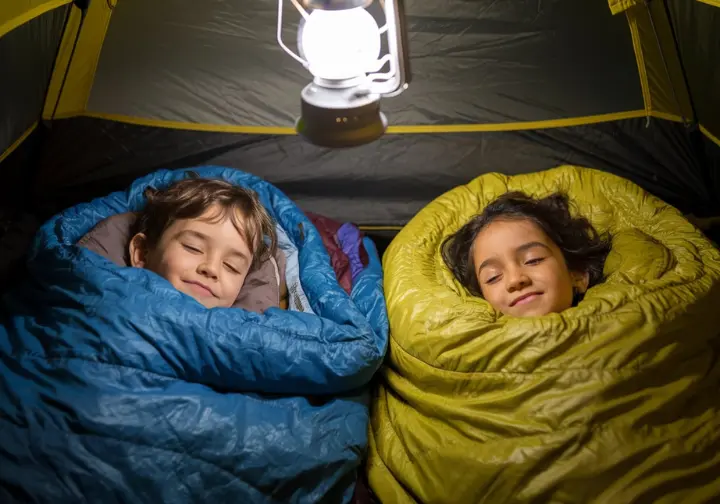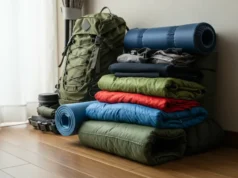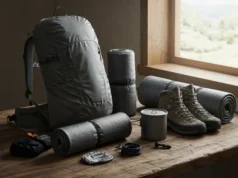In this article
When choosing a children’s sleeping bag, you’ll need to focus on temperature rating, size, and safety features. Select a bag rated 10 degrees lower than expected nighttime temperatures, and guarantee it matches your child’s height for ideal warmth. Kid-specific bags like the Morrison Outdoors Little Mo (for babies) or Big Agnes Duster (for older kids) offer crucial features including anti-pinch zippers, draft collars, and proper insulation. Look for synthetic fills like CloudLoft for durability and easy cleaning, or down for better compression. Consider mummy-style bags for maximum warmth or rectangular designs for more wiggle room. The following detailed guide will help you make the perfect choice for your young camper.
Summary
- Choose sleeping bags rated 10 degrees lower than expected nighttime temperatures to ensure proper warmth and comfort for children.
- Kid-specific bags feature shorter lengths, anti-pinch zippers, and easier-to-use designs that allow children to manage independently.
- The Morrison Outdoors Little Mo suits ages 6-24 months, while Big Agnes Duster accommodates growing children with adjustable lengths.
- Look for bags with draft collars, built-in pillows, and two-way zippers to enhance comfort and prevent cold spots.
- Select materials like ripstop nylon and synthetic insulation for durability, easy cleaning, and quick drying capabilities.
Ensuring Cozy Nights for Your Little Campers
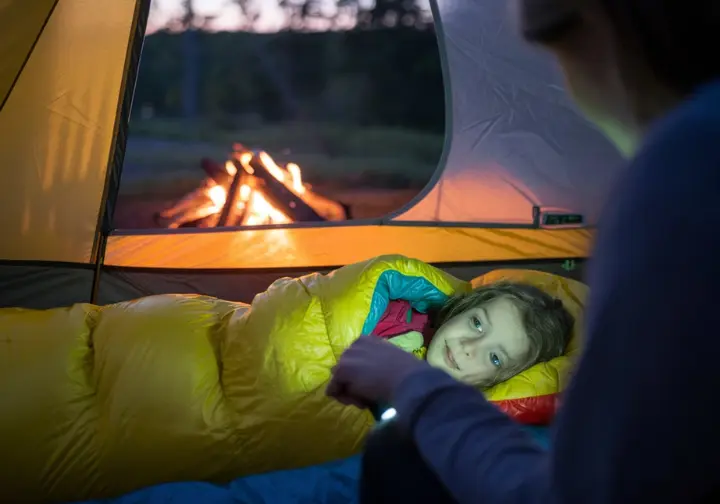
Three key factors make camping with kids successful: proper gear, comfort, and adequate sleep. When you’re looking for children’s sleeping bags, these elements come together to create the perfect outdoor experience for your little ones.
Start by selecting a snooze-inducing sleeping bag that’s particularly designed for cozy kids. You’ll want to evaluate the size, which should allow enough room for movement while maintaining warmth.
For both sleepovers and camping trips, choose a bag that’s rated 10 degrees lower than the expected nighttime temperature to guarantee proper insulation.
The right sleeping bag can transform naptime into a peaceful experience, whether you’re in the backyard or deep in the wilderness. Look for features like draft collars (insulated tubes that prevent cold air from entering around the neck), zipper guards to prevent snags, and built-in pillows for added comfort.
Interior pockets keep small comfort items within easy reach, as attachment loops make storage simple.
Evaluate washable materials that can handle the inevitable spills and accidents. Synthetic fills are typically more practical than down for children, as they maintain insulating properties even when damp and are usually less expensive to replace.
Understanding the Basics of Childrens Sleeping Bags
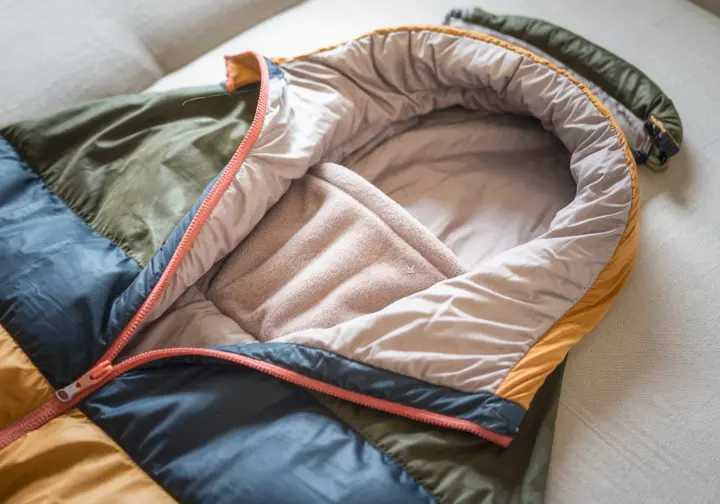
When you’re looking for a children’s sleeping bag, you’ll need to understand three key elements: temperature ratings which guarantee proper warmth, size specifications that match your child’s height, and material composition which affects both comfort and durability.
Your child’s sleeping bag should fit their specific needs, which means choosing between mummy-style bags for maximum warmth or rectangular designs for more wiggle room.
You’ll find that kid-specific sleeping bags aren’t just smaller versions of adult bags – they’re engineered with features like shorter lengths to prevent cold spots, easier-to-use zippers, and lightweight materials that your child can carry independently.
Key Concepts and Definitions
Grasping your child’s sleeping bag starts with understanding a few essential concepts. When you’re shopping for children’s camping sleeping bags, you’ll need to comprehend temperature ratings, which indicate the lowest temperature at which your child will stay warm. A bag with a 20-degree comfort rating means your child should sleep comfortably at this temperature.
You’ll additionally encounter two main insulation types: down and synthetic. Down provides excellent warmth for its weight but costs more, whereas synthetic insulation performs better when wet and is typically more affordable.
The sleeping bag’s shape matters too – mummy bags offer superior warmth but less movement, whereas rectangular bags give your child more room to stretch.
When it comes to proper sizing, you’ll want to avoid bags that are too large, as they won’t retain heat effectively. Look for bags that fit snugly while allowing some movement. If you’re considering a down bag, pay attention to the fill insulation rating – higher numbers mean better insulation.
For growing children, consider adjustable-length bags that can accommodate height changes over time.
Essential Features in Childrens Sleeping Bags
Understanding essential features in children’s sleeping bags will assist you in making an informed purchase for your child’s comfort and safety. You’ll want to focus on four key elements that determine the sleeping bag’s functionality and durability.
First, check the zipper quality, ensuring it has a no-snag design and two-way operation. This characteristic allows your child easily to get in and out during controlled ventilation.
The hood design matters too – look for contoured shapes that follow your child’s head, though avoid hoods altogether for infants because of safety concerns.
Your child’s growth needs consideration through adjustability features. Many bags offer creative solutions like pull-cord systems or expandable footboxes that accommodate different heights. You won’t need to replace the bag as frequently with these adaptable designs.
Finally, don’t overlook portability. A lightweight sleeping bag with a convenient stuff sack makes transport easier for your child, especially during camping trips.
Consider bags that compress well and include carrying straps. Materials like polycotton or polyester provide comfort whilst maintaining durability, and features like water-repellent coatings offer extra protection against the elements.
Why Kid-Specific Sleeping Bags Matter
Beyond knowing which features to look for, comprehension of why kid-specific sleeping bags matter can help you make smarter choices for your child’s outdoor comfort. Your child’s safety and warmth depend on selecting gear that’s particularly designed for their needs.
Optimized thermal efficiency is essential as children generate less body heat than adults. You’ll want a sleeping bag that fits your child’s body closely to prevent cold air pockets from forming. Adult-sized bags simply can’t provide the same level of warmth as a result of excess space.
Enhanced safety features, like anti-pinch zippers and the absence of dangerous drawstrings, protect your little one during sleep. When it comes to appropriate sizing, children’s sleeping bags are designed with particular proportions that match kids’ body shapes. They’re typically wider at the shoulders and narrower at the feet, ensuring improved comfort throughout the night.
You’ll find that properly sized bags prevent your child from sliding around or getting tangled. Many children’s sleeping bags likewise include specialized features like integrated pad sleeves and storage pockets, making them more functional for young campers.
Choosing the Right Childrens Sleeping Bags: Practical Considerations
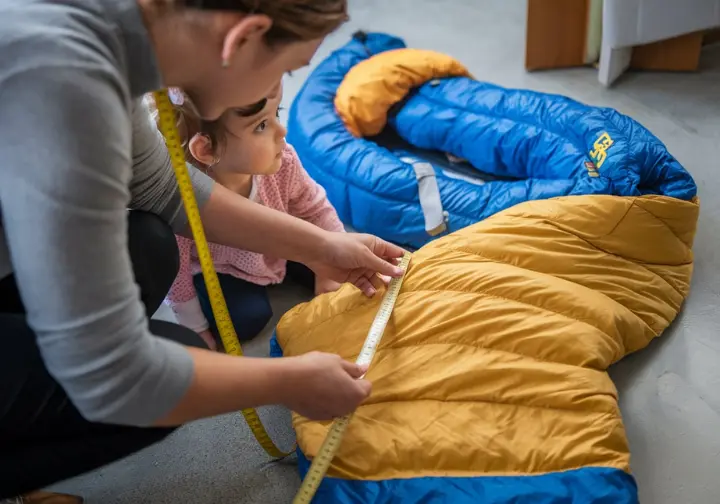
When you’re selecting a children’s sleeping bag, you’ll need to match it carefully to your camping environment and planned activities, considering factors like temperature ratings and seasonal use.
You’ll want to examine technical features such as zipper quality, shell material durability, and insulation type, which directly affect the bag’s performance and longevity.
To overcome common challenges like size adjustments and storage concerns, look for bags with expandable foot boxes, compression sacks, and easy-to-clean materials that grow with your child through multiple camping seasons.
Matching the Sleeping Bag to the Environment
The right sleeping bag can make the difference between a cozy night’s sleep and a miserable camping experience for your child. When selecting a bag, you’ll need to evaluate several key environmental factors that affect performance.
Start with temperature ratings to guarantee your child stays warm. If you’re camping in 40-degree weather, choose a bag rated slightly below this temperature for comfort. The insulation type matters too – down offers superior warmth for dry conditions, whereas synthetic works better in damp environments.
Your bag’s shape will furthermore impact warmth and comfort. Mummy bags retain heat effectively but restrict movement, whereas rectangular designs offer more space at the cost of thermal effectiveness.
Evaluate weight and packability based on your activities. For backpacking, you’ll want a lightweight, compact bag, typically with down insulation. Car camping allows for heavier, roomier options.
Don’t forget to check for specific features that match your environment, such as waterproof foot boxes for wet conditions or integrated pad sleeves to prevent sliding. These details can significantly impact your child’s comfort in different outdoor settings.
Technical Aspects to Keep in Mind
Comprehending technical aspects can make or break your child’s comfort in a sleeping bag. When evaluating options, you’ll need to understand several key components that affect performance and durability.
Start with fill efficiency, which measures insulation effectiveness in down bags – higher numbers mean better warmth for less weight. Next, examine shell materials, with ripstop nylon being an excellent choice for durability and water resistance. Your child’s comfort depends heavily on lining materials, so consider options like polyester or polycotton based on your needs. Don’t overlook zipper quality; look for no-snag designs with dual-way functionality. Construction details like dual-layer insulation and baffle systems determine how well the bag retains warmth.
Remember to match these technical aspects to your child’s specific needs and usage conditions. A bag that’s perfect for summer camping might not work for winter adventures, so choose accordingly based on these technical specifications.
Common Challenges and Solutions
Beyond technical specifications, parents face several practical hurdles when selecting sleeping bags for their children. Let’s address these challenges head-on with proven solutions.
First, consider adjustable sleeping bags that grow with your child. Look for models with expandable footboxes or zippers that extend the length, saving you money in the long run. To maintain warmth, choose mummy-style bags with draft collars and guarantee proper sizing – too much space inside means cold spots.
For safety, avoid bags with loose strings or hoods for younger children, and opt for wearable designs with built-in sleeves for toddlers.
Portability shouldn’t be overlooked when camping or traveling. Down-filled bags compress better than synthetic ones, though they’re pricier. Use compression sacks to reduce bulk during transport.
As for cleaning, select machine-washable options whenever possible. Synthetic materials dry faster than polycotton blends, making them more practical for frequent use. Always check care labels before washing to maintain the bag’s insulating properties.
Product Recommendations: Top Children’s Sleeping Bags
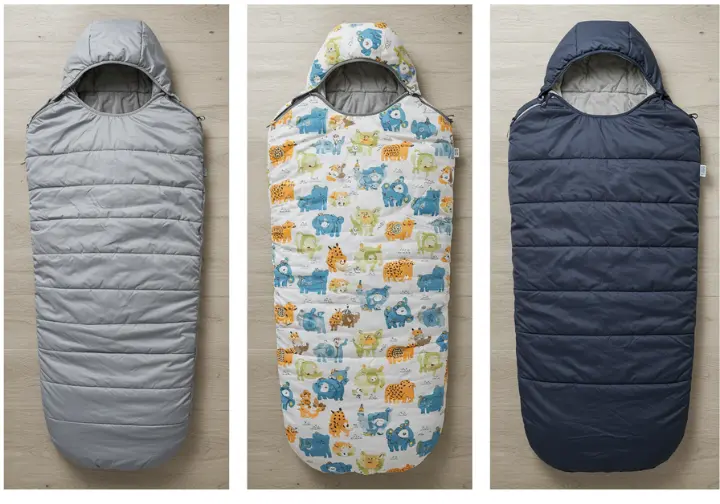
You’ll find age-specific sleeping bags designed to meet your child’s unique needs, from lightweight baby sleep sacks to rugged teen camping gear.
For outdoor adventures, consider temperature-rated options like the Morrison Outdoors Little Mo 20° for babies or the REI Co-op Kindercone 25 for school-age children.
When shopping for older kids and teens, look for versatile bags that offer both warmth and independence, such as the Big Agnes Explorer which combines technical features with easy-to-use designs.
Best Sleeping Bags for Babies and Toddlers
When choosing sleeping bags for your littlest adventurers, you’ll find the Morrison Outdoors Little Mo offers exceptional warmth with its groundbreaking baby-safe design rated for temperatures down to 20°F.
The Wildkin Nap Mat presents a more versatile option, doubling as both a sleeping bag and portable rest station for toddlers.
These trusted options combine safety features like snag-free zippers and appropriately sized dimensions with practical elements such as machine-washable materials and carrying straps for easy transport.
Morrison Outdoors Little Mo
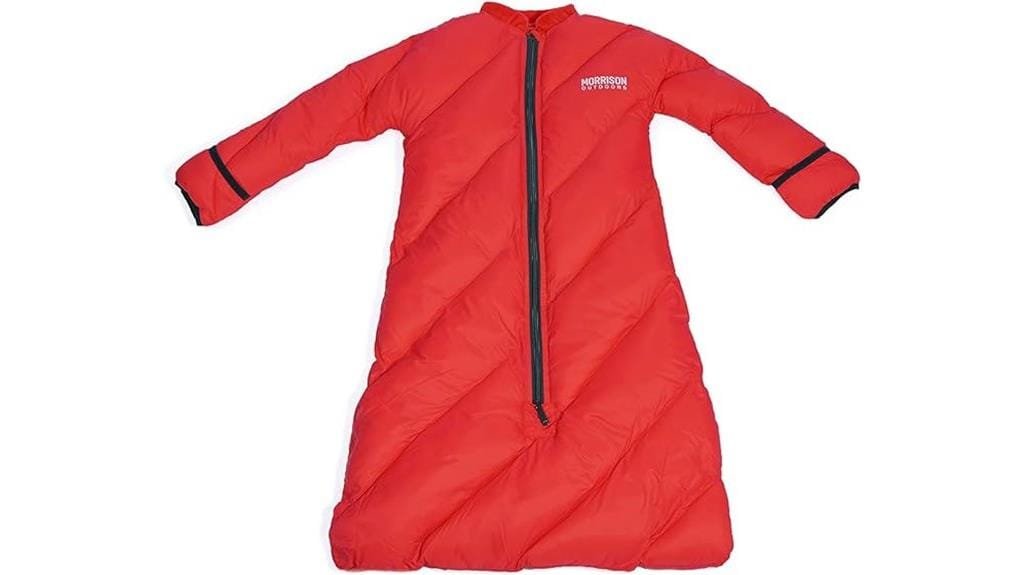
For parents seeking a safe and cozy sleeping solution for their littlest campers, the Morrison Outdoors Little Mo 40° Baby Sleeping Bag stands out as a top choice.
You’ll find this lightweight 16-ounce bag delivers reliable warmth down to 40°F through its synthetic insulation and thoughtful design features like the enclosed foot box and draft tube.
The bag’s safety-first design corresponds with AAP guidelines, featuring a snug collar and no dangerous drawstrings or hoods.
You can easily manage diaper changes thanks to the bottom-up zipper design, as the patent-pending construction adjusts to fit your growing baby from 6 to 24 months.
When you’re packing up, simply compress the bag into its included stuff sack for compact storage.
For chilly nights, layer your little one with warm pajamas to maximize comfort in temperatures approaching 40°F.
Best For: Parents looking for a safe, lightweight sleeping bag for camping with infants aged 6-24 months who want a product that adheres to AAP safety guidelines and offers versatile temperature regulation.
PROS:
- Meets AAP safety standards with no hood or drawstrings.
- Bottom-up zipper design allows easy diaper changes.
- Adjustable design grows with baby from 6-24 months.
CONS:
- The slippery exterior makes picking up the baby more challenging.
- Limited to temperatures above 40°F.
- Higher price point compared to standard baby sleep sacks.
Wildkin Nap Mat
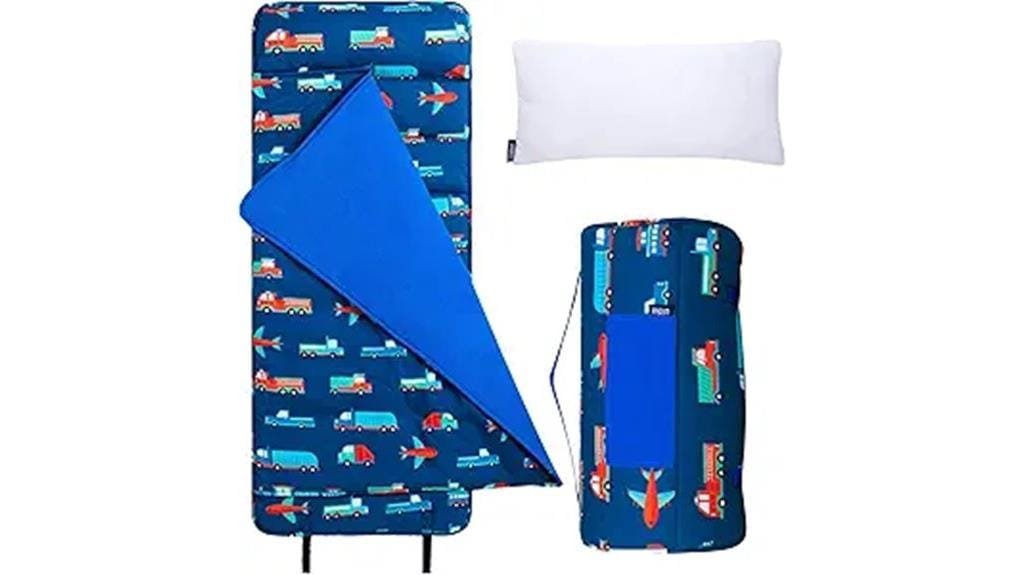
The Wildkin Original Nap Mat stands out as an ideal choice for parents seeking a versatile sleeping solution for daycare, preschool, or sleepovers.
You’ll find the 50 x 20 x 1.5-inch dimensions provide ample space for your toddler while remaining compact enough for easy storage and transport.
The nap mat’s thoughtful design combines practicality with comfort. The cotton-polyester blend material offers durability and softness, whereas the attached blanket and built-in pillow guarantee your child stays cozy without overheating.
You can easily maintain the mat by removing the pillow and washing it in your front-loading machine on a gentle cycle.
The roll-up design with hook and loop fasteners makes it simple for your child to manage independently.
Whether you’re using it for daycare or camping trips, the carrying handle and coordinating patterns make this mat both functional and appealing to young children.
Best For: Parents seeking a comfortable, portable nap solution for toddlers and preschoolers who need a sleeping mat for daycare, sleepovers, or light camping use.
PROS:
- Easy-to-clean design with machine-washable materials and removable pillow.
- All-in-one solution with attached blanket and built-in pillow.
- Kid-friendly roll-up design with carrying handle for independent use.
CONS:
- May only last about one school year with regular use.
- The size might be too small for older children.
- Air drying is recommended, which takes longer than machine drying.
Top Sleeping Bags for Camping and Outdoor Adventures
When you’re planning outdoor adventures with kids, you’ll want to check out the Kelty Mistral Kids Sleeping Bag and REDCAMP Mummy Sleeping Bag, which both offer excellent temperature ratings below 40°F.
The Kelty Mistral stands out with its synthetic fill and easy-to-pack design, making it perfect for young campers who need to manage their own gear.
You’ll find the REDCAMP Mummy’s tapered shape provides superior warmth retention while keeping the total weight under 3 pounds, ideal for backpacking trips and overnight camping adventures.
Kelty Mistral Kids Sleeping Bag
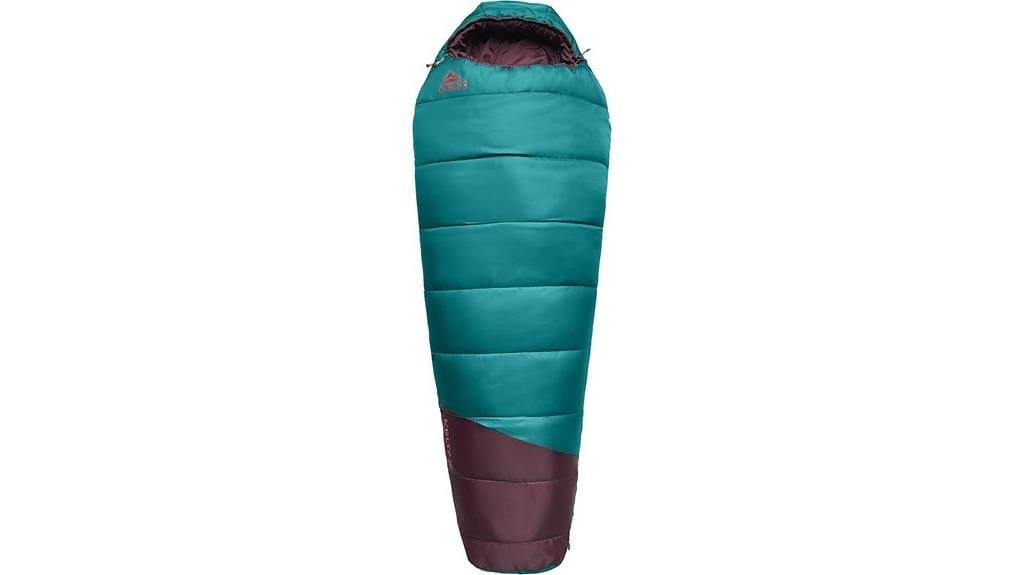
Parents seeking a reliable sleeping bag for their young adventurers will value the USA-made Kelty Mistral Kids Sleeping Bag.
You’ll discover this sleeping bag offers exceptional warmth with its CloudLoft synthetic insulation and offset quilting design that eliminates cold spots, making it suitable for temperatures down to 20°F.
The bag’s dimensions accommodate children up to 54-56 inches tall, with a spacious foot box that provides extra comfort during sleep.
You’ll find the practical features, including a hood that fits inflatable pillows and a convenient stuff sack for easy transport.
The polyester construction delivers durability while keeping the weight manageable for young campers.
For growing children, you’ll get excellent value from this versatile sleeping bag.
Its quality construction and temperature rating makes it ideal for various camping conditions, from summer nights to cooler mountain adventures, especially when paired with hiking boots that provide essential support during outdoor activities.
Best For: Young campers and growing children who need a reliable sleeping bag for temperatures down to 20°F, especially suitable for those up to 56 inches tall.
PROS:
- High-quality CloudLoft synthetic insulation with offset quilting prevents cold spots.
- Made in the USA with durable polyester construction and convenient stuff sack.
- Spacious design allows room for growth while maintaining warmth.
CONS:
- May be too large for very small children, affecting heat retention.
- Some users report need for modifications to improve warmth.
- The price point might be higher compared to basic children’s sleeping bags.
REDCAMP Mummy Sleeping Bag
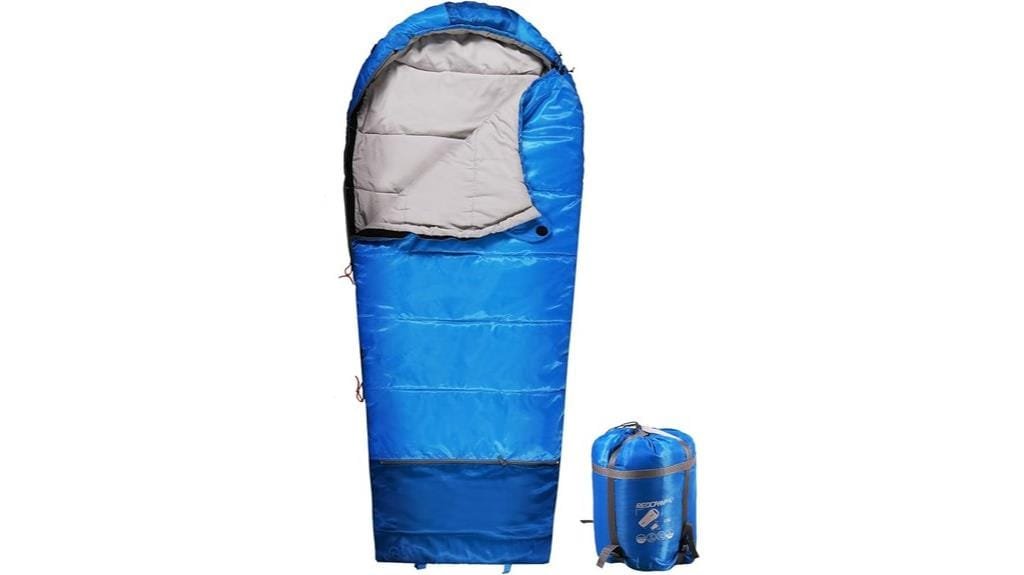
Designed for young adventurers aged up to 12 years, REDCAMP’s Mummy Sleeping Bag offers versatile comfort in temperatures between 41-59°F, making it ideal for three-season camping and indoor sleepovers.
You’ll find practical features like an adjustable length that zips down to 46 inches for smaller children and a soft inner liner that prevents zipper snags.
At just 2.4 pounds, you won’t have trouble carrying this sleeping bag to your destination. The included storage bag comes with adjustable straps for easy transport, though you might need to practice the art of repacking.
Choose between pink or blue options, both featuring insulated zipper plackets for enhanced warmth. Although the zippers may occasionally need attention to prevent unzipping, the durable polyester construction and 365-day warranty guarantee you’re making a solid investment in your child’s outdoor comfort.
Best For: Young campers and sleepover enthusiasts aged 4-12 who need a versatile, three-season sleeping bag for both indoor and outdoor use in moderate temperatures.
PROS:
- Adjustable length accommodates different sizes and growing children.
- Lightweight design (2.4 lbs) with included storage bag makes it portable.
- The soft inner liner and insulated zipper plackets provide good warmth and comfort.
CONS:
- Zippers may come undone during use and require attention.
- Can be challenging to repack into the storage bag.
- Limited temperature range may not be suitable for colder weather camping.
Recommended Sleeping Bags for Older Children and Teens
You’ll find excellent quality and reliability in both the Big Agnes Duster and The North Face Wasatch Pro 20 sleeping bags for your older child or teen.
The Big Agnes Duster offers synthetic insulation which is perfect for growing kids, with adjustable length features that will extend the bag’s usability through multiple seasons.
The North Face Wasatch Pro 20 stands out with its 20-degree temperature rating and durable water-repellent finish, making it an ideal choice for serious young campers who need dependable gear for varying conditions.
Big Agnes Duster
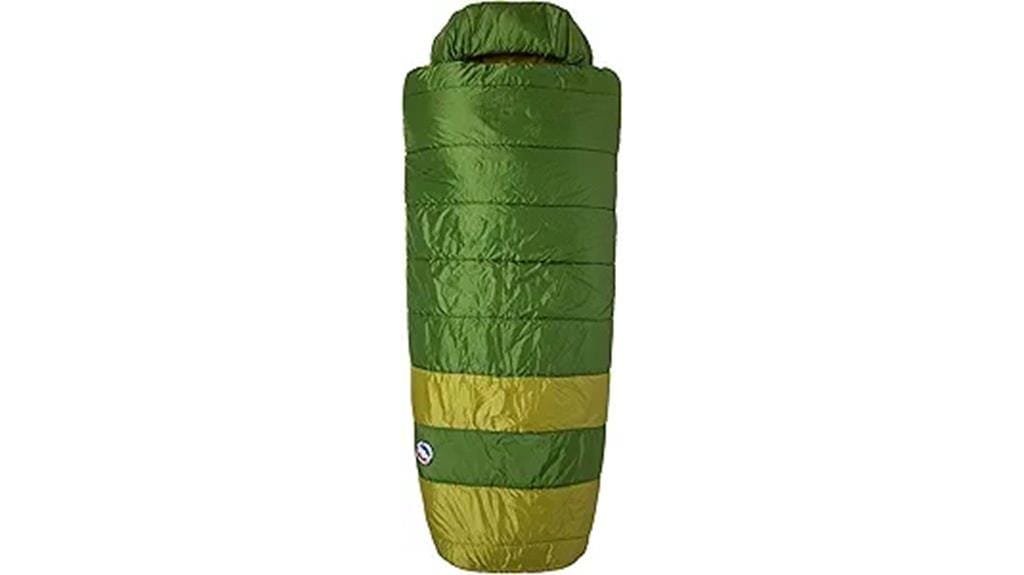
The Big Agnes Echo Park synthetic sleeping bag delivers exceptional comfort for growing teens and active young campers who need extra space to move.
You’ll value the roomy 78-inch length and 30-inch width, which accommodates growth spurts as it maintains warmth with FireLine MAX synthetic insulation rated to 20 degrees.
You can customize this versatile bag to your teen’s sleeping style. The Flex Pad Sleeve attaches to sleeping pads between 25-30 inches wide, preventing midnight sliding, as the Free Range Hood allows natural head movement.
The quilt-like construction feels more like a bed than a traditional mummy bag, and the top corner hand pockets let you wrap it around like a comforter.
For temperature regulation, you’ll find multiple zipper configurations that provide excellent venting options, and the no-draft collar and wedge design keep cold air out when temperatures drop.
Best For: Growing teens and young campers seeking a spacious, versatile sleeping bag that adapts to their changing needs while providing reliable warmth down to 20 degrees.
PROS:
- Generous dimensions accommodate growth and movement while maintaining warmth.
- Innovative pad attachment system prevents sliding during sleep.
- Versatile design allows for multiple configurations and venting options.
CONS:
- Relatively heavy at 3 pounds for backpacking use.
- Storage sacks could be better designed.
- Higher price point compared to basic sleeping bags.
The North Face Wasatch Pro 20
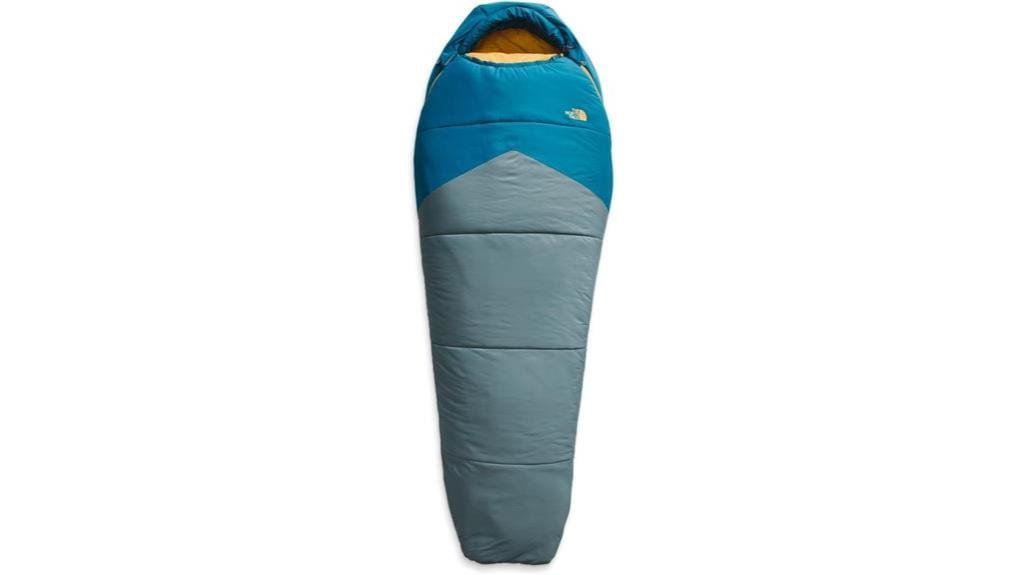
For older kids and teens seeking a reliable sleeping bag from a trusted outdoor brand, North Face’s Wasatch Pro 20 delivers comfort in a right-hand orientation with its durable nylon construction.
You’ll find that this sleeping bag offers a perfect balance of weight and functionality at 4000 grams, making it manageable for young backpackers to carry independently.
The Wasatch Pro 20’s dimensions (14.17 x 11.81 x 3 inches) provide ample space for growing bodies during the maintenance of a compact profile when packed.
Its Banff Blue and Goblin Blue color combination adds visual appeal without sacrificing practicality.
The zipper closure system guarantees easy entry and exit, whereas the nylon outer material resists wear and tear during outdoor adventures.
When you’re ready to store or transport the sleeping bag, it compresses effectively to fit within the package dimensions, allowing for convenient storage in your gear closet or vehicle.
Best For: Older children and teenagers who need a durable sleeping bag for backpacking trips and outdoor adventures, particularly in moderate weather conditions.
PROS:
- High-quality nylon construction from a reputable outdoor brand.
- Practical size dimensions that accommodate growing kids while remaining packable.
- Attractive blue color scheme that appeals to youth while maintaining functionality.
CONS:
- Relatively heavy at 4000 grams, which may be challenging for smaller children to carry.
- Higher price point compared to basic children’s sleeping bags.
- Right-hand orientation may not suit all users’ preferences.
Final Thoughts: Wrapping Up the Best Children’s Sleeping Bag Guide
Selecting an ideal children’s sleeping bag doesn’t need to feel overwhelming when you focus on the vital factors we’ve covered. Temperature ratings should be your first consideration, ensuring your child stays warm in various weather conditions.
Keep in mind that comfort and safety go hand in hand – a well-fitted bag provides both thermal efficiency and peace of mind.
Throughout this guide, we’ve examined how different features serve specific purposes for kids’ outdoor adventures. You’ll want to prioritize sleeping bags with quality insulation, appropriate size specifications, and durability that matches your intended use.
Whether you’re planning casual backyard camping or serious wilderness expeditions, there’s a perfect option for your needs.
Before making your final decision, double-check the temperature ratings against your typical camping conditions, and consider how your child might grow over the next few seasons.
Don’t overlook factoring in the sleeping bag’s weight and packability if you’re planning hiking trips.
Popular Questions
What Size Sleeping Bag for a 5-Year-Old?
Can a 5-Year-Old Use an Adult Sleeping Bag?
Can a 3-Year-Old Sleep in a Sleeping Bag?
What Should a 2-Year-Old Sleep in When Camping?
We are a participant in the Amazon Services LLC Associates Program, an affiliate advertising program designed to provide a means for sites to earn advertising fees by advertising and linking to Amazon.com. As an Amazon Associate I earn from qualifying purchases. We also participate in other affiliate programs. The information provided on this website is provided for entertainment purposes only. We make no representations or warranties of any kind, expressed or implied, about the completeness, accuracy, adequacy, legality, usefulness, reliability, suitability, or availability of the information, or about anything else. Any reliance you place on the information is therefore strictly at your own risk. Additional terms are found in the terms of service.



